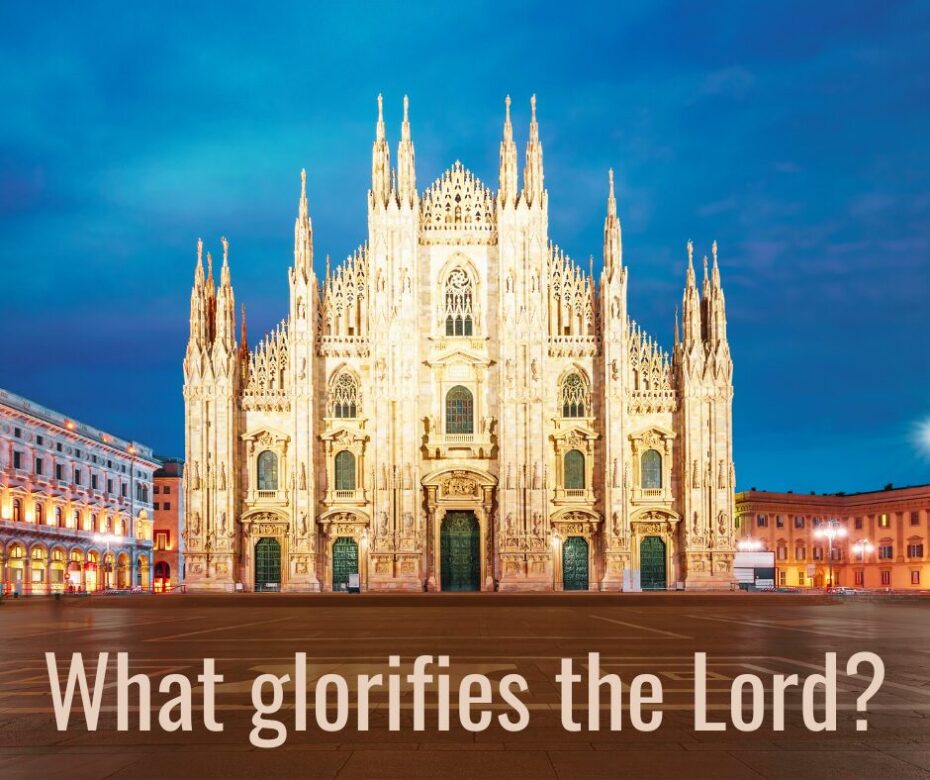Recently, I had the opportunity to visit Milan, Italy’s Duomo Cathedral–the most impressive building in which I’ve ever been. While there, most of what I heard and read about it was in Italian. I might not have all the facts straight, but I’m pretty sure I got the main points down. Construction of the cathedral began in the late 1300s and took about 600 years to complete. It is the fourth-largest cathedral in the world. It’s huge!
There are fifty-two pillars on the inside, corresponding to the number of weeks in a year. I’m guessing that the domed roof is around 100 feet high, and the pillars around eighty feet each. It would be almost impossible to count the number of stained-glass windows, monuments, tapestries, and other works of art in the building. They are priceless. The altar is very large and ornate. Large gargoyles located all over the roof act as water gutters.
The artifacts cover a wide range of categories. Interspersed with sculptures depicting various Biblical scenes are ancient statues of people who donated to the construction of the church. There are statues of Greek gods. In the sanctuary or adjoining rooms are the coffins of important men associated with the church. The cathedral claims to have one of the nails used to crucify Christ. It’s kept under a red light and brought out on certain occasions for people to see.
One of the most obvious features is the adoration of Mary. In fact, she is the focus in this impressive building. There are many statues dedicated to her. The very top of the cathedral has such a statue, which is the first thing visitors see. It extends perhaps 200 feet into the air and is visible from far away. The cathedral says that all who visit Milan have the privilege of sharing in Mary’s light and that her arms embrace the entire world.
A work of art that caught my attention depicts Saint Lucy. Her statue is missing its eyes. Church tradition says that she had them gouged out when she was martyred. She was put to death because she was dedicated to the church and refused to marry. We were told that some men who worked on the construction of the cathedral became blind because of the marble that would fly into their eyes as they worked with the material. They could find comfort in their blindness, however, because they could pray to Lucy, the patron saint of the blind, for help during their remaining difficult years. I have to think that a blind man in the 1500s would have had a particularly hard existence. My very confident guess is that the church did very little to alleviate their suffering. Lucy would take care of that.
This cathedral is held by many to be a monument to the glory of God. Its purpose is to show His majesty.
Clearly, it has failed in its mission. I cannot think of any building that does less to promote the glory and majesty of God. What superstitious nonsense is on display within its walls! We can also think of the money spent on its construction and upkeep over the past 700 years. The common people would have been used to finance it, as well as provide the laborers for it. Some died and others were permanently disabled in the process. I am sure that there were many patron saints, in addition to Lucy, who could help them with their specific problems. All they had to do was to find, somewhere in the building, the right statue to pray to.
This building has nothing to do with the glory of God. It is a monument to the glory of rich and powerful men. Oscar Wilde, no friend of Christianity, had the same feelings, albeit for different reasons. After visiting it in 1875, he wrote: “The cathedral is an awful failure. Outside the design is monstrous and inartistic…everything in it is vile…”
From a Christian perspective, we must conclude that its opulence is indeed vile. The way people were treated during all those centuries was as well. Imagine building something like this, robbing people of their wealth and health, and claiming that you were doing it for the glory of Christ. The people even paid for and worked on the statues supposedly provided for their relief–statues that had no value for them whatsoever.
I believe Christ had a similar feeling when he saw the corruption and robbery going on in the impressive temple of His day. After seeing how the religious leaders in that building encouraged a poor widow to give her last few cents, He told His disciples that the structure would one day be torn down (Mark 12:41–13:2).
That temple and the cathedral in Milan have something in common. They are religious buildings, engaged in practices that do not reflect the teachings of the Scriptures. Religion not based on those teachings will produce what I saw in Milan.


